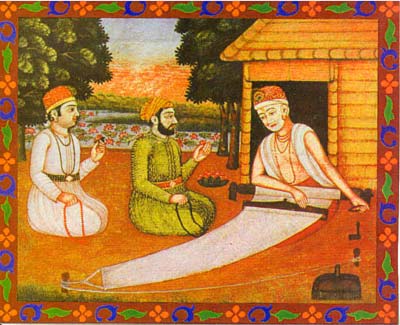
Ratha Jatra, the Festival of Chariots of Lord Jagannatha is celebrated every year at Puri, the temple town in Orissa, on the east coast of India. The presiding deities of the main temple, Sri Mandira, Lord Jagannatha, Lord Balabhadra and Goddess Subhadra, with the celestial wheel Sudarshana are taken out from the temple precincts in an elaborate ritual procession to their respective chariots. The huge, colourfully decorated chariots, are drawn by hundreds and thousands of devotees on the bada danda, the grand avenue to the Gundicha temple, some two miles away to the North. After a stay for seven days, the deities return to their abode in Srimandira.
Pahandi
The journey of the deities to the world outside, starts with an elaborate royal ritual called Pahandi - literally, going forward in a step by step movement to the accompaniment of several devotees beating the ghanta, kahali and telingi baja.
Significance of Ratha Jatra
The festival is also known as Gundicha Jatra, Ghosa Jatra, Navadina Jatra, Dasavatara Jatra and by a variety of other names. For the devoted and believers, it is considered the most auspicious occasion. Rathe tu vamanam drishtwa punarjanmam na vidyate A glimpse of the Vamana, the dwarf form, an incarnation of Lord Jagannatha, is sure to ensure emancipation, release from the cycle of birth and death.Jatra is an essential part of the ritual of the Hindu system of worship. Jatra literally means travel or journey. Normally, it is the representative deities of temples more popularly known as Utsava Murti in south and Chalanti Pratima or Bije Pratima in Orissa, partake in these journeys. It is rarely that the presiding deities come out of the sanctum for such ritual journeys. The Jatra for the Ritual Journey take two forms – one involving the short circumbulation around the temple and other involving a longer journey from the temple to some other destination. The Jatra is considered as an important part of festivities and ceremonies of each temple and is considered as a special and sacred occasion.Rath Jatra being unique among all Jatras is the grandest festival of the supreme divinity who has manifested himself in the Kali Yuga to emancipate humanity and to relieve them from their sufferings. Lord Jagannatha is identified fully with Vishnu and Krishna. In his original manifestation as Nilamadhaba, he was worshipped in a sacred Nyagrodha Briksha or banyan tree. The branches of the tree had spread for several miles and any one entering this area was instantly emancipated and was relieved of the travails of the birth and re-birth. In fact, the influence of Yama, the God of Death, is supposed to have been curtailed in the sacred city of Puri – Srikshetra on account of the presence of Lord Jagannatha and therefore it is also called the Yamanika Tirtha.
The Chariots
The three chariots of Balabhadra, Subhadra and Jagannatha are newly constructed every year with wood of specified trees like phassi, dhausa, etc.and decorated as per the unique scheme prescribed and followed for centuries stand on the Bada Danda, the Grand Avenue.
Lord Jagannatha’s Chariot is called Nandighosa. It is forty-five feet high and forty-five feet square at the wheel level. It has sixteen wheels, each of seven feet diameters, and is decked with a cover made of red and yellow cloth. Lord Jagannatha is identified with Krishna who is also known as Pitambara, the one attired in golden yellow robes and hence the distinguishing yellow stripes on the canopy of this chariot.
The Chariot of Lord Balabhadra, called the Taladhwaja, the one with the Palm Tree on its flag, has fourteen wheels, each of seven feet diameters and is covered with red and blue cloth. Its height is forty-four feet.
The Chariot of Subhadra, known as Darpadalana, literally trampler of pride, is forty-three feet high with twelve wheels, each of seven feet diameters. This Chariot is decked with a covering of red and black cloth, black being traditionally associated with Shakti and the Mother goddess.
The Chariot of Lord Balabhadra, called the Taladhwaja, the one with the Palm Tree on its flag, has fourteen wheels, each of seven feet diameters and is covered with red and blue cloth. Its height is forty-four feet.
The Chariot of Subhadra, known as Darpadalana, literally trampler of pride, is forty-three feet high with twelve wheels, each of seven feet diameters. This Chariot is decked with a covering of red and black cloth, black being traditionally associated with Shakti and the Mother goddess.





0 Comments